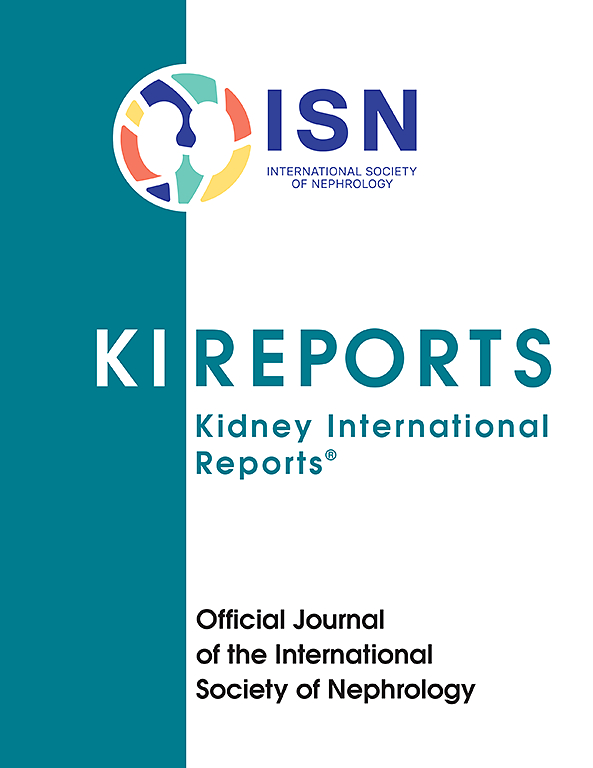原发性膜性肾病患者抗利妥昔单抗的发生和临床结局
IF 5.7
2区 医学
Q1 UROLOGY & NEPHROLOGY
引用次数: 0
摘要
利妥昔单抗是原发性膜性肾病(pMN)的一线治疗药物,具有良好的疗效和安全性。使用单克隆抗体如利妥昔单抗可导致抗药物抗体的形成,这可能会干扰治疗反应。在pMN中,抗利妥昔单抗抗体(ARAs)已被证明可以中和利妥昔单抗的细胞毒性,从而增加肾病综合征复发的风险。然而,随着时间的推移,ARA的动力学和ARA滴度对预后的影响尚不清楚。方法回顾性国际多中心研究纳入74例接受利妥昔单抗治疗的pMN患者。在这里,我们旨在阐明ARA与临床结果之间的相关性,并评估ARA检测的最佳时机。结果总体而言,74例患者中有35例(47%)在给予利妥昔单抗后中位时间为9个月(四分位数间距:6-12个月)发生ARAs。在第9个月、第12个月和再给利妥昔单抗之前进行ARA监测,发现88%的ARAs患者。ARAs患者给予利妥昔单抗后6个月和12个月的临床缓解率显著降低(分别为31%对56%,P = 0.03和54%对87%,P = 0.0017)。ARAs与更高的复发率(63% vs. 29%, P = 0.036)和6个月时更高的b细胞重建率(74.2% vs. 50%, P = 0.048)相关。值得注意的是,ARAs患者复发时间较早(22个月比32个月,P = 0.01)。结论ARAs的发生是影响pMN预后的重要因素之一,与利妥昔单抗治疗后缓解率降低和复发率升高显著相关。对于这些患者,应考虑使用obinutuzumab或ofatumumab进行替代治疗。本文章由计算机程序翻译,如有差异,请以英文原文为准。

Anti-Rituximab Antibodies Occurrence and Clinical Outcomes in Patients With Primary Membranous Nephropathy
Introduction
Rituximab is a first-line treatment for primary membranous nephropathy (pMN), with proven efficacy and safety. The use of monoclonal antibodies such as rituximab can lead to the formation of antidrug antibodies that may interfere with the therapeutic response. In pMN, anti-rituximab antibodies (ARAs) have been shown to neutralize the cytotoxicity of rituximab, thereby increasing the risk of relapse of nephrotic syndrome. However, the kinetics of ARAs over time and the effect of ARA titer on prognosis are unclear.
Methods
This retrospective international multicenter study included 74 patients with pMN treated with rituximab. Here we aimed to clarify the correlation between ARAs and clinical outcome, as well as to evaluate the most appropriate timing of ARA detection.
Results
Overall, 35 out of 74 patients (47%) developed ARAs after a median of 9 (interquartile range: 6–12) months following rituximab administration. ARA monitoring at month-9, month-12 and before rituximab readministration identified 88% of patients with ARAs. Clinical remission rate at 6 and 12 months after rituximab administration was significantly lower in patients with ARAs (31% vs. 56%, P = 0.03 and 54% vs. 87%, P = 0.0017, respectively). ARAs were associated with a significantly higher rate of relapse (63% vs. 29%, P = 0.036) and a higher rate of B-cell reconstitution at 6 months (74.2% vs. 50%, P = 0.048). Notably, relapse occurred earlier in patients with ARAs (22 months vs. 32 months, P = 0.01).
Conclusion
The development of ARAs represents one of the most important prognostic factors in pMN, being significantly associated with a reduced remission rate and a higher relapse rate after rituximab therapy. Alternative therapies with obinutuzumab or ofatumumab should be considered for these patients.
求助全文
通过发布文献求助,成功后即可免费获取论文全文。
去求助
来源期刊

Kidney International Reports
Medicine-Nephrology
CiteScore
7.70
自引率
3.30%
发文量
1578
审稿时长
8 weeks
期刊介绍:
Kidney International Reports, an official journal of the International Society of Nephrology, is a peer-reviewed, open access journal devoted to the publication of leading research and developments related to kidney disease. With the primary aim of contributing to improved care of patients with kidney disease, the journal will publish original clinical and select translational articles and educational content related to the pathogenesis, evaluation and management of acute and chronic kidney disease, end stage renal disease (including transplantation), acid-base, fluid and electrolyte disturbances and hypertension. Of particular interest are submissions related to clinical trials, epidemiology, systematic reviews (including meta-analyses) and outcomes research. The journal will also provide a platform for wider dissemination of national and regional guidelines as well as consensus meeting reports.
 求助内容:
求助内容: 应助结果提醒方式:
应助结果提醒方式:


